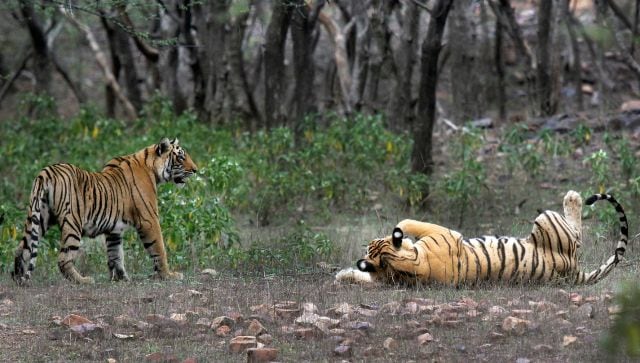If there is one country that has been highly successful in tiger conservation, it is India. According to the 2022 Census, there are 3,167 tigers across the country, accounting for nearly 75 per cent of the world’s wild tiger population. The 2018 Census released in July 2019 put this figure at 2,967. India has seen a gradual surge in the number of tigers, from 1,411 in 2006 to 2,226 in 2014. Besides efforts by wildlife conservationists and forest officials, experts cite nature tourism as one of the reasons for the roaring success in increasing the number of tigers in India. On International Tiger Day, let’s take a look at how tourism has impacted India’s tiger conservation efforts. India’s tiger story There were an estimated 1,827 tigers when then Prime Minister Indira Gandhi launched Project Tiger at the Jim Corbett National Park in 1973. It was aimed at not just reviving the dwindling tiger population but also preserving their natural habitat as these big cats are at the top of the food chain, noted Indian Express. Marking 50 years of Project Tiger in April this year, Prime Minister Narendra Modi said the success of the project “has been a matter of pride for not only India but the entire world. India has not only saved the tiger but has also given it a great ecosystem to flourish.”
India currently has 53 tiger reserves spanning over 75,000 sq km, a significant rise from just nine five decades back.
Speaking to PTI, wildlife conservationist Prerna Bindra said: “This achievement of conservatising tigers, despite our population density and other pressures, hasn’t come easy and it’s been a gradual process since the onset of Project Tiger. We can be justifiably proud that the tiger continues to thrive in India, even as it is unfortunately extinct in some range countries. This success can be attributed to our people’s tolerance, political will and a strong legal and policy framework, one of the strongest in the world”. [caption id=“attachment_12930702” align=“alignnone” width=“640”] India has seen a gradual increase in the number of tigers over the years. Reuters File Photo[/caption] Moreover, protecting tigers leads to saving forest ecosystems as these apex predators keep a check on herbivores, which would otherwise clear forests of plants and trees, conservation experts told the financial newspaper Nikkei Asia. “Protecting the tiger means protecting large landscapes and everything within, from butterflies to frogs, and termites to elephants, as well as the trees and the rivers,” Anish Andheria, president of the Wildlife Conservation Trust, a Mumbai-based nonprofit conservation agency, was quoted as saying by the newspaper. Role of tiger tourism Experts have acknowledged the role of nature tourism in protecting endangered species. Wildlife enthusiasts run to tiger parks such as Ranthambore, Pench, Bandhavgarh, Tadoba and Sariska to catch a glimpse of the majestic creature every year. Tiger tourism not only generates revenues for these reserves but also for the local communities and conservation bodies. Wildlife expert Julian Matthews told The Telegraph in 2015 that nature tourism is “providing the invaluable economic imperative, the myriad of local jobs, and the millions of passionate advocates for the parks that still harbour the greatest densities of tigers in India”. Matthews, also a founder of Travel Operators for Tigers, wrote for Outlook Traveller, in 2019: “Visitors pay to see the mystical cat in its mythical lands. The passionate visitor returns home to advocate and petition for the beast’s long-term security. Safari-goers make authorities and protectors accountable for what’s in these wild landscapes day in and day out. They fund the building of an economy that generates rural jobs and new livelihoods that make a landscape and its creatures worth preserving.” A study by the Centre for Wildlife Studies published in Nature journal last September showed that tigers were the biggest attraction for tourists visiting Bandipur, Kanha and Sundarbans tiger reserves. “Since nature tourism is gaining popularity, we conducted a survey to understand tourists’ preferences – this could help managers of protected areas to strategise and generate revenue better,” the lead author of the study Dincy Mariyam said at the time. [caption id=“attachment_12930712” align=“alignnone” width=“640”]
India has seen a gradual increase in the number of tigers over the years. Reuters File Photo[/caption] Moreover, protecting tigers leads to saving forest ecosystems as these apex predators keep a check on herbivores, which would otherwise clear forests of plants and trees, conservation experts told the financial newspaper Nikkei Asia. “Protecting the tiger means protecting large landscapes and everything within, from butterflies to frogs, and termites to elephants, as well as the trees and the rivers,” Anish Andheria, president of the Wildlife Conservation Trust, a Mumbai-based nonprofit conservation agency, was quoted as saying by the newspaper. Role of tiger tourism Experts have acknowledged the role of nature tourism in protecting endangered species. Wildlife enthusiasts run to tiger parks such as Ranthambore, Pench, Bandhavgarh, Tadoba and Sariska to catch a glimpse of the majestic creature every year. Tiger tourism not only generates revenues for these reserves but also for the local communities and conservation bodies. Wildlife expert Julian Matthews told The Telegraph in 2015 that nature tourism is “providing the invaluable economic imperative, the myriad of local jobs, and the millions of passionate advocates for the parks that still harbour the greatest densities of tigers in India”. Matthews, also a founder of Travel Operators for Tigers, wrote for Outlook Traveller, in 2019: “Visitors pay to see the mystical cat in its mythical lands. The passionate visitor returns home to advocate and petition for the beast’s long-term security. Safari-goers make authorities and protectors accountable for what’s in these wild landscapes day in and day out. They fund the building of an economy that generates rural jobs and new livelihoods that make a landscape and its creatures worth preserving.” A study by the Centre for Wildlife Studies published in Nature journal last September showed that tigers were the biggest attraction for tourists visiting Bandipur, Kanha and Sundarbans tiger reserves. “Since nature tourism is gaining popularity, we conducted a survey to understand tourists’ preferences – this could help managers of protected areas to strategise and generate revenue better,” the lead author of the study Dincy Mariyam said at the time. [caption id=“attachment_12930712” align=“alignnone” width=“640”] Experts say the tiger population is more in areas that attract more tourists. AP File Photo[/caption] Previous studies have shown that Indian tourists account for nearly 96 per cent of all visitors to nature reserves across the country, noted Nature. According to the Nikkei Asia report, the number of tigers has seen a hike in areas that are more popular with tourists. This may be because tourists help in keeping a check on poaching activity as well as sometimes contribute to unearthing previously unknown knowledge about tigers. Daleep Akoi, conservationist and proprietor of Jim’s Jungle Retreat, an eco-friendly wildlife lodge near Uttarakhand’s Jim Corbett National Park, told the newspaper, “As soon as tourism picks up, there is more government attention on the park, which actually means better monitoring and protection mechanisms.” ALSO READ:
India’s tiger population is rising and so is that of humans: How will we accommodate the big cats?
Concerns about nature tourism While experts have noted the many positives of tiger tourism, some have flagged the lesser talked about concerns. Unregulated tourism can lead to tigers being reduced to a “selfie experience” as seen in some countries, according to a 2016 report by World Animal Protection, a UK-based not-for-profit agency that works for animal welfare, reported Nikkei Asia. In 2019, scat samples from tigers in Madhya Pradesh’s Bandhavgarh and Kanha Tiger Reserves found that the big cats were more stressed during the tourist season than otherwise, reported Outlook magazine. Wildlife scientists have also called for the protection of tribal people who are largely dependent on forests for their livelihood and food sources. In 2015, London-based charity Survival International released a statement advocating for thousands of Baiga and Gond tribal people who were “illegally” evicted from the Kanha Tiger Reserve. Stephen Corry, Survival’s then director, said at the time, as per The Telegraph: “What’s happening in Kanha epitomises the ugly side of the conservation industry – thousands of tourists career through the park in noisy jeeps, clamouring to take photos of the beleaguered tigers.” “Meanwhile, Baiga communities that have carefully managed the tiger’s habitat over generations are annihilated by forced evictions.” Wildlife activists contend that nature tourism should not be banned but regulated. According to Outlook, Qamar Qureshi, senior scientist at the Wildlife Institute of India, said earlier: “Wildlife tourism is a very important tool for conservation. By placing a ban on tourism, we would be robbing an entire generation of that experience and a chance to take up conservation as a profession.” With inputs from agencies
Experts say the tiger population is more in areas that attract more tourists. AP File Photo[/caption] Previous studies have shown that Indian tourists account for nearly 96 per cent of all visitors to nature reserves across the country, noted Nature. According to the Nikkei Asia report, the number of tigers has seen a hike in areas that are more popular with tourists. This may be because tourists help in keeping a check on poaching activity as well as sometimes contribute to unearthing previously unknown knowledge about tigers. Daleep Akoi, conservationist and proprietor of Jim’s Jungle Retreat, an eco-friendly wildlife lodge near Uttarakhand’s Jim Corbett National Park, told the newspaper, “As soon as tourism picks up, there is more government attention on the park, which actually means better monitoring and protection mechanisms.” ALSO READ:
India’s tiger population is rising and so is that of humans: How will we accommodate the big cats?
Concerns about nature tourism While experts have noted the many positives of tiger tourism, some have flagged the lesser talked about concerns. Unregulated tourism can lead to tigers being reduced to a “selfie experience” as seen in some countries, according to a 2016 report by World Animal Protection, a UK-based not-for-profit agency that works for animal welfare, reported Nikkei Asia. In 2019, scat samples from tigers in Madhya Pradesh’s Bandhavgarh and Kanha Tiger Reserves found that the big cats were more stressed during the tourist season than otherwise, reported Outlook magazine. Wildlife scientists have also called for the protection of tribal people who are largely dependent on forests for their livelihood and food sources. In 2015, London-based charity Survival International released a statement advocating for thousands of Baiga and Gond tribal people who were “illegally” evicted from the Kanha Tiger Reserve. Stephen Corry, Survival’s then director, said at the time, as per The Telegraph: “What’s happening in Kanha epitomises the ugly side of the conservation industry – thousands of tourists career through the park in noisy jeeps, clamouring to take photos of the beleaguered tigers.” “Meanwhile, Baiga communities that have carefully managed the tiger’s habitat over generations are annihilated by forced evictions.” Wildlife activists contend that nature tourism should not be banned but regulated. According to Outlook, Qamar Qureshi, senior scientist at the Wildlife Institute of India, said earlier: “Wildlife tourism is a very important tool for conservation. By placing a ban on tourism, we would be robbing an entire generation of that experience and a chance to take up conservation as a profession.” With inputs from agencies
)